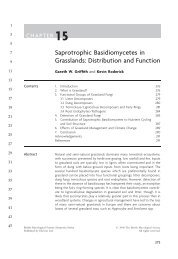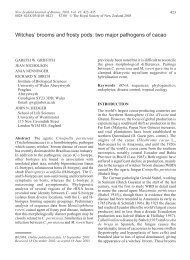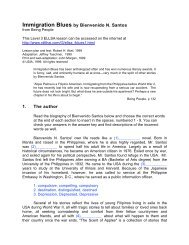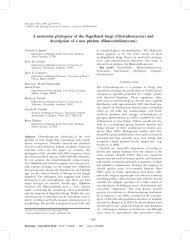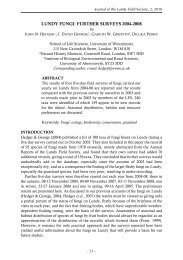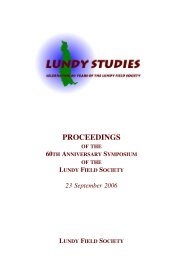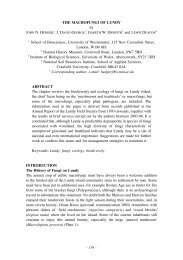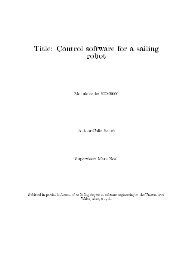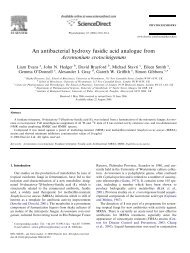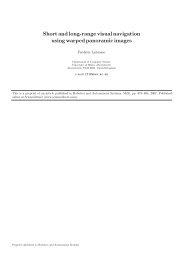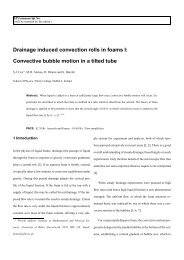Anaerobic rumen fungi
Anaerobic rumen fungi
Anaerobic rumen fungi
Create successful ePaper yourself
Turn your PDF publications into a flip-book with our unique Google optimized e-Paper software.
ANAEROBIC RUMEN FUNGI<br />
Bauchop T and Mountfort DO (1981). Cellulose fermentation by a <strong>rumen</strong> anaerobic fungus in both the absence and<br />
presence of <strong>rumen</strong> methanogens. Appl Environ Microbiol 42: 1103-1110.<br />
Becker ER and Hsiung TS (1929). The method by which ruminants acquire their fauna of infusoria, and remarks<br />
concerning experiments on the host specificity of these protozoa. Proc Natl Acad Sci (USA) 15: 684-690.<br />
Benchimol M, Johnson PJ and De Souza W (1996). Morphogenesis of the hydrogenosome: an ultrastructural study.<br />
Biol Cell 87: 197-205.<br />
Bernalier A, Bogaert C, Fonty G and Jouany JP (1989). Effect of ionophore antibiotics on <strong>rumen</strong> anaerobic <strong>fungi</strong>. In:<br />
Nolan JV, Leng RA and Demeyer DI (eds). The roles of protozoa and <strong>fungi</strong> in ruminant digestion. Australia:<br />
Armidale, Penambul Books, pp 273-275.<br />
Bernalier A, Fonty G and Gouet P (1991). Cellulose degradation by two <strong>rumen</strong> anaerobic <strong>fungi</strong> in monoculture or in<br />
coculture with <strong>rumen</strong> bacteria. Anim Feed Sci Tech 32: 131-136.<br />
Bernalier A, Fonty G, Bonnemoy F and Gouet P (1992). Degradation and fermentation of cellulose by the <strong>rumen</strong><br />
anaerobic <strong>fungi</strong> in axenic cultures or in association with cellulolytic bacteria. Curr Microbiol 25: 143-148.<br />
Bernalier A, Fonty G, Bonnemoy F and Gouet P (1993). Inhibition of the cellulolytic activity of Neocallimastix frontalis<br />
by Ruminococcus flavefaciens. J Gen Microbiol 139: 873-880.<br />
Borneman WS and Akin DE (1990). Lignocellulose degradation by <strong>rumen</strong> <strong>fungi</strong> and bacteria: Ultrastructure and cell<br />
wall degrading enzymes. In: Akin DE, Ljungdahl LG, Wilson JR and Harris PJ (eds). Microbial and Plant<br />
Opportunities to Improve Lignocellulose Utilization by Ruminants. New York: Elsevier, pp 325-339.<br />
Borneman WS, Akin DE and Ljungdahl LG (1989). Fermentation products and plant cell wall degrading enzymes<br />
produced by monocentric and polycentric anaerobic <strong>rumen</strong> <strong>fungi</strong>. Appl Environ Microbiol 55: 1066-1073.<br />
Borneman WS, Ljungdahl LG, Hartley RD and Akin DE (1992). Purification and partial characterization of two<br />
feruloyl esterases from the anaerobic fungus Neocallimastix strain MC2. Appl Environ Microbiol 58: 3762-3766.<br />
Braune R (1913). Untersuchungen uber die in Weider Kavermayen Vorkommenden Protozoen. Arch Protistenk 32:<br />
111-170.<br />
Breton A, Bernalier A, Bonnemoy F, Fonty G, Gaillard B and Gouet P (1989). Morphological and metabolic<br />
characterization of a new species of strictly anaerobic <strong>rumen</strong> fungus : Neocallimastix joyonii. FEMS Microbiol<br />
Lett 58: 309-314.<br />
Breton A, Bernalier A, Dusser M, Fonty G, Gaillard-Martinie B and Guillot J (1990). Anaeromyces mucronatus nov. gen,<br />
nov. sp. A new strictly anaerobic <strong>rumen</strong> fungus with polycentric thallus. FEMS Microbiol Lett 70: 177-182.<br />
Breton A, Dusser M, Gaillard-Martinie B, Guillot J, Millet L and Prensier G (1991). Piromyces rhizinflata nov. sp, a<br />
strictly anaerobic fungus from the faeces of the Saharan ass: a morphological, metabolic and ultrastructural<br />
study. FEMS Microbiol Lett 66:1-8.<br />
Brookman JL, Mennim G, Trinci APJ, Theodorou MK and Tuckwell DS (2000a). Identification and characterization of<br />
anaerobic gut <strong>fungi</strong> using molecular methodologies based on ribosomal ITS1 and 18S rRNA. Microbiol 146: 393-<br />
403.<br />
Brookman JL, Ozkose E, Rogers S, Trinci APJ and Theodorou MK (2000b). Identification of spores in the polycentric<br />
anaerobic gut <strong>fungi</strong> which enhance their ability to survive. FEMS Microbiol Ecol 31:261-267.<br />
Brownlee AG (1989). Remarkably AT-rich genomic DNA from the anaerobic fungus Neocallimastix. Nucleic Acids<br />
Res 17:1327-1335.<br />
Cabe TKM (1998). Production of cellulolytic enzymes using immobilized anaerobic <strong>fungi</strong>. PhD dissertation.<br />
University of Western Sydney, Macarthur, Australia.<br />
Chen H, Li X and Ljungdhal LG (1994). Isolation and properties of an extracellular â-glucosidase from the polycentric<br />
<strong>rumen</strong> fungus Orpinomyces sp. strain PC-2. Appl Environ Microbiol 60: 64-70.<br />
Davies DR, Theodorou MK and Trinci APJ (1990). <strong>Anaerobic</strong> <strong>fungi</strong> in the digestive tract and faeces of growing steers:<br />
evidence for a third stage in their life cycle. In: Reisinger A and Bresinsky A (eds). Fourth International<br />
Mycological Congress. Germany: Regensburg, pp 226.<br />
Davies DR, Theodorou MK, Lawrence MIG and Trinci APJ (1993). Distribution of anaerobic <strong>fungi</strong> in the digestive<br />
tract of cattle and their survival in faeces. J Gen Microbiol 139: 1395-1400.<br />
Dayanand TL, Nagpal R, Puniya AK, Sehgal JP and Singh K (2007). In-vitro degradation of urea-NH treated wheat<br />
3<br />
straw using anaerobic ruminal <strong>fungi</strong>. J Anim Feed Sci 16: 484-489.<br />
Dehority BA and Orpin CG (1996). Development of, and natural fluctuations in, <strong>rumen</strong> microbial populations. In:<br />
Hobson PN, Stewart CS (eds). The Rumen Microbial Ecosystem. London: Chapman and Hall, pp 196–245.<br />
387



